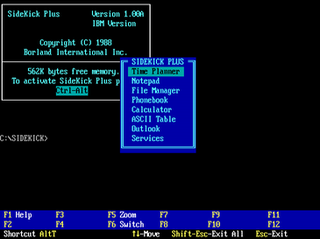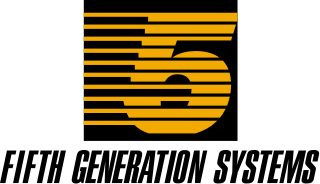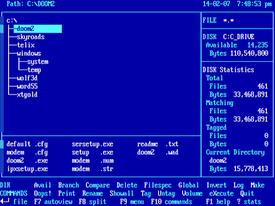
The Apple II series of microcomputers was initially designed by Steve Wozniak, manufactured by Apple Computer, and launched in 1977 with the Apple II model that gave the series its name. It was followed by the Apple II Plus, Apple IIe, Apple IIc, and Apple IIc Plus, with the 1983 IIe being the most popular. The name is trademarked with square brackets as Apple ][, then, beginning with the IIe, as Apple //. In terms of ease of use, features, and expandability, the Apple II was a major advancement over its predecessor, the Apple I, a limited-production bare circuit board computer for electronics hobbyists.
A file manager or file browser is a computer program that provides a user interface to manage files and folders. The most common operations performed on files or groups of files include creating, opening, renaming, copying, moving, deleting and searching for files, as well as modifying file attributes, properties and file permissions. Folders and files may be displayed in a hierarchical tree based on their directory structure.

IBM PC compatible computers are technically similar to the original IBM PC, XT, and AT, all from computer giant IBM, that are able to use the same software and expansion cards. Such computers were referred to as PC clones, IBM clones or IBM PC clones. The term "IBM PC compatible" is now a historical description only, since IBM no longer sells personal computers after it sold its personal computer division in 2005 to Chinese technology company Lenovo. The designation "PC", as used in much of personal computer history, has not meant "personal computer" generally, but rather an x86 computer capable of running the same software that a contemporary IBM PC could. The term was initially in contrast to the variety of home computer systems available in the early 1980s, such as the Apple II, TRS-80, and Commodore 64. Later, the term was primarily used in contrast to Apple's Macintosh computers.

AppleWorks was an integrated office suite containing a word processor, database, and spreadsheet. It was developed by Rupert Lissner for Apple Computer, originally for the Apple II platform and launched in 1984. Many enhancements for AppleWorks were created, the most popular being the TimeOut series from Beagle Bros which extended the life of the Apple II version of AppleWorks. Appleworks was later reworked for the Macintosh platform.

Borland Sidekick was a personal information manager (PIM) launched by American software company Borland in 1984 under Philippe Kahn's leadership. It was an early and popular terminate-and-stay-resident program (TSR) for MS-DOS which enabled computer users to activate the program using a hot key combination while working in other programs. Although a text-mode program, Sidekick's window-based interface echoed that of the Apple Macintosh and anticipated the eventual look of Microsoft Windows 2.0. It included a personal calendar, text editor, calculator, ASCII chart, address book, and phone dialer. According to the prospectus for Borland's initial public offering of stock to the public, Sidekick sold more than 1 million copies in its first three years.

GHOST, now Symantec™ GHOST Solution Suite (GSS) for enterprise, is a disk cloning and backup tool originally developed by Murray Haszard in 1995 for Binary Research. The technology was acquired in 1998 by Symantec.

Norton Commander (NC) is a discontinued prototypical orthodox file manager (OFM), written by John Socha and released by Peter Norton Computing. NC provides a text-based user interface for managing files on top of MS-DOS. It was officially produced between 1986 and 1998. The last MS-DOS version of Norton Commander, 5.51, was released on July 1, 1998.

DOS Shell is a file manager that debuted in MS-DOS and PC DOS version 4.0, released in June 1988. It was no longer included in MS-DOS version 6, but remained part of the Supplemental Disk. The Supplemental Disk could be ordered or could be downloaded through Microsoft's FTP server. DOS Shell was retained in PC DOS until PC DOS 2000.
Norton AntiVirus is an anti-virus or anti-malware software product founded by Peter Norton, developed and distributed by Symantec since 1990 as part of its Norton family of computer security products. It uses signatures and heuristics to identify viruses. Other features included in it are e-mail spam filtering and phishing protection.

Norton Utilities is a utility software suite designed to help analyze, configure, optimize and maintain a computer. The latest version of the original series of Norton Utilities is Norton Utilities 16 for Windows XP/Vista/7/8 was released 26 October 2012.
WinPlus, originally Plus, was a cross-platform clone of the HyperCard application that enabled users to run HyperCard stacks on Apple Macintosh, Microsoft Windows and OS/2 Presentation Manager.

PC Tools is a collection of software utilities for DOS developed by Central Point Software.
WinFax is a discontinued Microsoft Windows-based software product developed and published by Delrina designed to let computers equipped with fax-modems communicate directly to stand-alone fax machines, or other similarly equipped computers.

Norton SystemWorks is a discontinued utility software suite by Symantec Corp. It integrates three of Symantec's most popular products – Norton Utilities, Norton CrashGuard and Norton AntiVirus – into one program designed to simplify solving common PC issues. Backup software was added later to high-end editions. SystemWorks was innovative in that it combined several applications into an all-in-one software for managing computer health, thus saving significant costs and time often spent on using different unrelated programs. SystemWorks, which was introduced in 1998 has since inspired a host of competitors such as iolo System Mechanic, McAfee Nuts And Bolts, Badosoft First Aid and many others.
Central Point Software, Inc. was a leading software utilities maker for the PC market, supplying utilities software for the DOS and Microsoft Windows markets. It also made Apple II copy programs. Through a series of mergers, the company was ultimately acquired by Symantec in 1994.

In computing, the trash, also known by other names such as dustbin, wastebasket, and others, is a graphical user interface desktop metaphor for temporary storage for files set aside by the user for deletion, but not yet permanently erased. The concept and name is part of Mac operating systems, a similar implementation is called the Recycle Bin in Microsoft Windows, and other operating systems use other names.
Amiga support and maintenance software performs service functions such as formatting media for a specific filesystem, diagnosing failures that occur on formatted media, data recovery after media failure, and installation of new software for the Amiga family of personal computers—as opposed to application software, which performs business, education, and recreation functions.

Fifth Generation Systems, Inc., was a computer security company founded October 1984 in Baton Rouge, Louisiana, United States by Robert Mitchell, Leroy Mitchell, Roger Ivey, and Bruce Ray. All four later left the company after it was acquired by Barry Bellue who was accused by the founders of fraud and continued theft from company accounts for illegal personal use. Fifth Generation's initial commercial product was FastBack, an early competitor to The Norton Backup from Symantec.
Synex Systems Corporation, a subsidiary of Synex International Inc., was formed in 1983 in an effort to develop software for the microcomputer market and was run by Synex International Vice President Murray Hendren until 1992. In 2002, Synex Systems was acquired by privately owned Lasata Software of Perth, Australia. In 2005, Lasata was acquired by UK based Systems Union. In 2007, Systems Union was acquired by privately held Infor Global Solutions, a U.S. company that specializes in enterprise software.

Mac OS is the series of operating systems developed for the Macintosh family of personal computers by Apple Computer, Inc. from 1984 to 2001, starting with System 1 and ending with Mac OS 9. The Macintosh operating system is credited with having popularized the graphical user interface concept. It was included with every Macintosh that was sold during the era in which it was developed, and many updates to the system software were done in conjunction with the introduction of new Macintosh systems.













